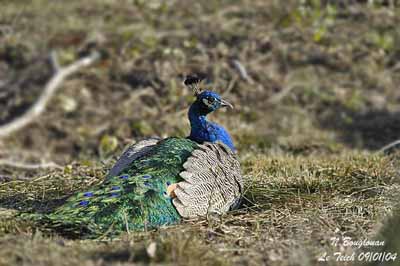
Fr: Paon bleu
All : Pfau
Esp : Pavo-real Común
Ital: Pavone comune
Sd: Påfågel
Nd: Blauwe Pauw
Text and pictures by Nicole Bouglouan
Sources :
HANDBOOK OF THE BIRDS OF THE WORLD Vol 2 by Josep del Hoyo-Andrew Elliot-Jordi Sargatal - Lynx Edicions - ISBN: 8487334156
Citation: Hennache, A. & Ottaviani, M. (2005). Monographie des faisans, volume 1. Edition W.P.A. France, Clères, France. ISBN: 2-9512467-1-4
Citation: Hennache, A. & Ottaviani, M. (2006). Monographie des faisans, volume 2. Edition W.P.A. France, Clères, France.ISBN: 2-9512467-2-2
"Les auteurs renoncent à leurs droits d'auteurs pour que la vente de cet ouvrage, publié par la World Pheasant Association, soit destinée à soutenir des projets de conservation."
ANIMALS – Explore, discover, connect
SORA Searchable Ornithological Research Archive (Blair O. Wolf)
Wikipedia (Wikipedia, The Free Encyclopedia)
Indian Peafowl
Pavo cristatus
Galliforme Order – Phasianidae Family
BIOMETRICS:
Male:
Length: 180-230 cm (tail: 40-45 cm – train: 140-160 cm)
Wingspan: 130-160 cm
Weight: 4000-6000 g
Female:
Length: 90-100 cm (tail: 32-37cm)
Wingspan: 80-130 cm
Weight: 2750-4000 g
DESCRIPTION:
The Indian Peafowl is the National Bird of India where this superb bird is sacred and very prominent in mythology and folklore of Indian people. Several legends tell numerous wonderful stories about this beautiful bird. Thanks to its beauty and popularity, the species has been protected both in its native and introduced ranges.
Very common in India, the Indian Peafowl is found in almost all villages and protected under Indian Wildlife Protection act, 1972.

Male is named peacock, female is peahen and chick is peachick.
Adult male has glossy cobalt-blue head, neck, upper mantle and breast. On the back, the centre is glossy green with scaled effect. The upperwing shows chestnut primary flight feathers and black secondaries. Wing coverts are black finely vermiculated white.
The long uppertail coverts form the train during the spring and all the breeding season. These feathers show ornamental eye-spot and disintegrated barbs at tip. These barbs give a fluffy appearance when the male fans its tail. On the contrary, the rectrices are duller and shorter.
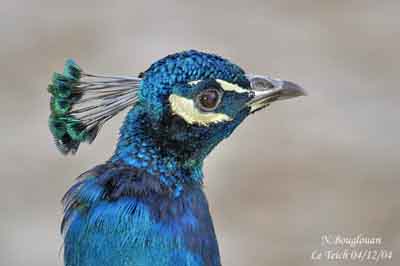
On the head, the bare skin is white, forming an oval line around the eyes. We can see a conspicuous crest of several fine feathers ending in blue-green fan.
The strong bill is grey with white spot at base. Eyes are dark brown. Legs and feet are pinkish, with feathered chestnut thighs. There is one spur on the rear of the leg.
After the breeding season, the male moults and its train disappears until the next spring.
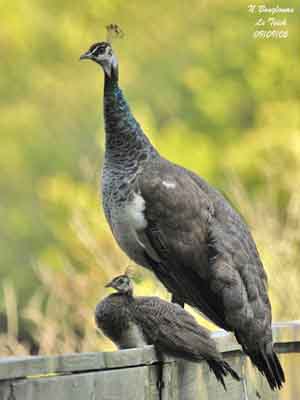
The female is different with brownish upperparts. The flight feathers and rectrices are darker brown. The neck is glossy green whereas the breast is dark brown with green gloss. Underparts, lower breast and belly, are whitish.
On the head, she has glossy green forehead and crown, with the same form of crest but greenish at tip. The bare skin of the face is white, and joins the white chin, throat, cheeks and lower ear-coverts.
The juvenile resembles female but duller and paler, and it lacks the glossy green feathers.
The young male has chestnut-coloured wings.
They are sexually mature at three years old.
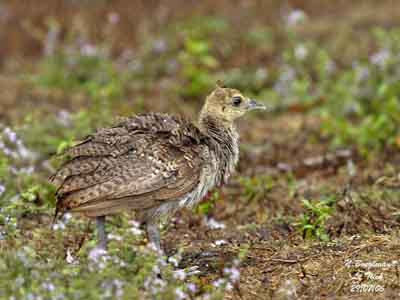
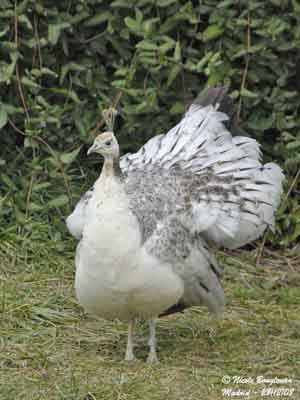
We can find several other colours from colour mutations through selective breeding. The white race is the most common.
VOICE:
The Indian Peafowl is noisy during the breeding season, giving loud, high-pitched calls. Alarm calls are produced by both sexes.
This species may call at night if threatened, and sometimes, several other peafowls respond.
HABITAT:
The Indian Peafowl favours open forest with riparian undergrowth, and wooded areas along streams. But this species is also found in orchards and cultivated areas near human habitations. It usually prefers moist and dry deciduous woodlands near water.
The Indian Peafowl can be seen up to 2000 metres of elevation.
RANGE:
The Indian Peafowl is found in Pakistan, throughout India to Sri Lanka, and maybe still in Bangladesh.
This beautiful bird has been introduced in numerous countries.
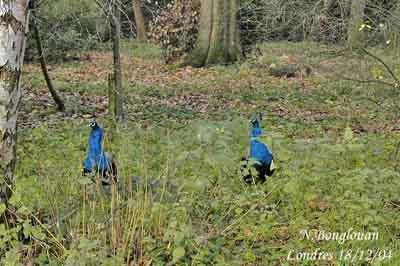
BEHAVIOUR:
The Indian Peafowl is omnivorous, feeding on grain, insects, small reptiles and mammals. It also takes berries, wild figs and green crops.
It forages in early morning and late afternoon in cultivated areas and fallow land. It can be seen in small groups. Outside the breeding season, there are only males, whereas during the nuptial period, it forages with females and young.
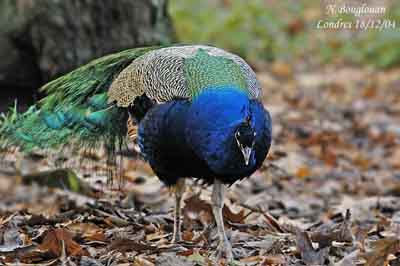
The Indian Peafowl is polygamous. During the breeding season, a small territory is established by each male, used for the courtship displays. Several “dancing-grounds” are close to each other, forming a lek that involves frequent territorial disputes. The owner strongly defends its area with threat displays, and then, by fighting if necessary.
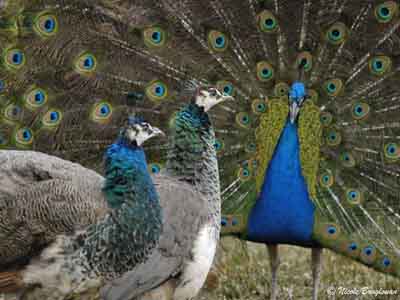
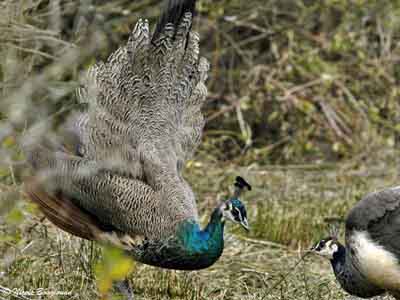
The females visit the males at lek, wandering through several territories, singly or in groups. The males are displaying, raising and fanning the superb train close to one female or in front of her. Regularly, the fanned feathers vibrate, producing some buzzy noise. The females look at them and finally return to the preferred male, usually the one with more eye-spots on the train (from an observation made in England).
Copulation occurs and then, the female remains alone until the end of the nesting season.
The adult males maintain their territory until the end of the breeding season when the train feathers is moulting.
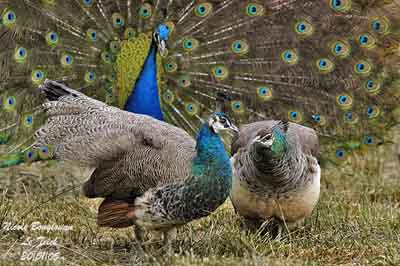
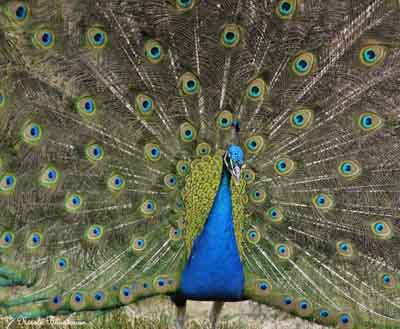
During the day, the Indian Peafowl rests in trees to avoid the terrestrial predators. At night, it also roosts high in dead trees, often on the top branches.
This species is probably sedentary in the same area all year round.
FLIGHT:
The Indian Peafowl can fly, in spite of the long train. But as most of Phasianids, it prefers to walk, climb or even run to escape a danger.
REPRODUCTION:
The breeding season varies according to the range, but usually occurs in wet season.
The nest of the Indian Peafowl is placed on the ground, hidden in scrub vegetation (Lantana, Zizyphus), but it can be slightly elevated in flood-prone areas.
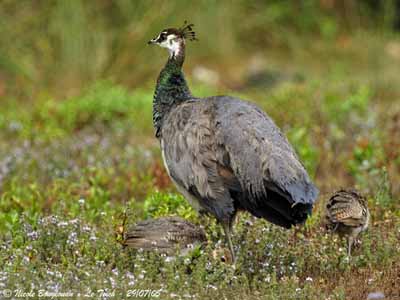
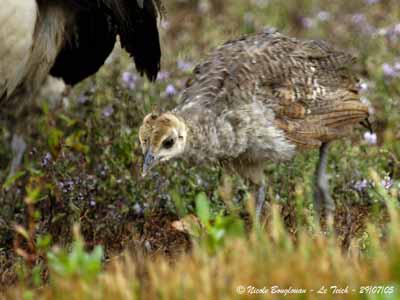
The female lays 3-6 pale brown eggs and incubates alone during about 28-30 days. The chicks are precocial and follow their mother very soon after hatching. She leads them at good food sources and the chicks learn how to feed themselves, imitating their mother.
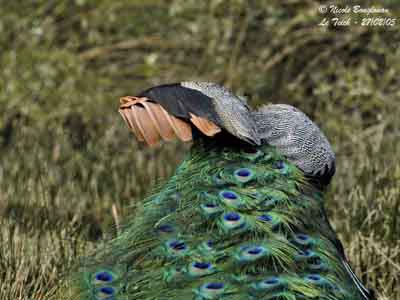
DIET:
The Indian Peafowl is omnivorous, feeding on plant matter, insects, small snakes and mammals, berries, some fruits and green crops.
It forages in small groups in cultivated areas.
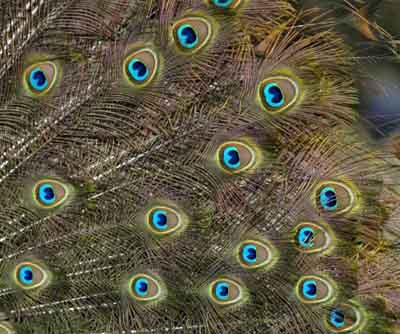
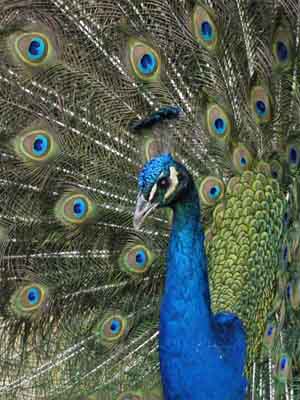
PROTECTION/THREATS/ STATUS:
The Indian Peafowl takes advantage of its association with humans. It is protected of course in India as national Bird, but also in many areas because this bird is sacred and has religious importance. This species often lives in villages where the bird is protected.
For this time, the beauty of a species saved it! The Indian Peafowl has been brought from its native country to other parts of the world, and this fact has probably saved the species from extinction. The close association with humans has given peafowls a great way to survive.